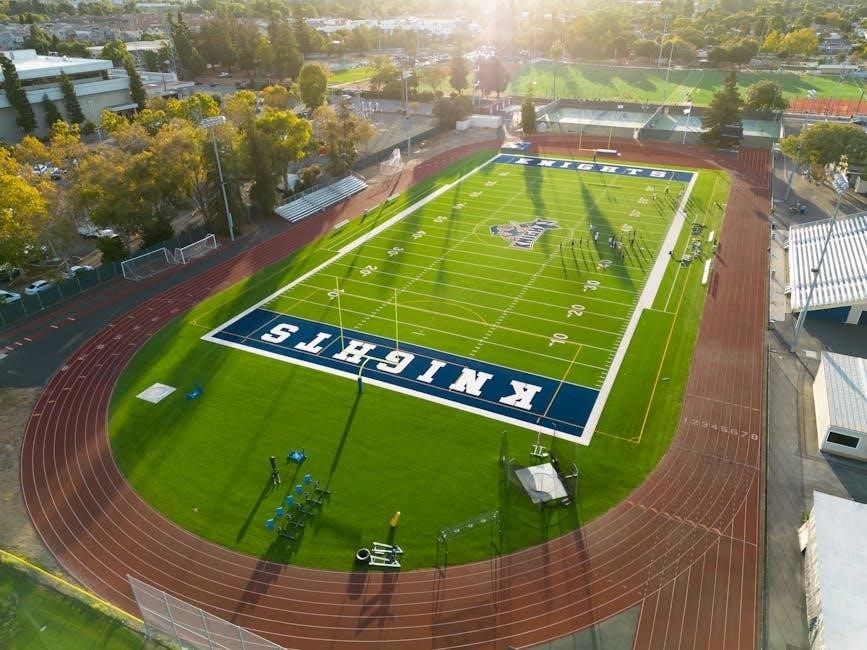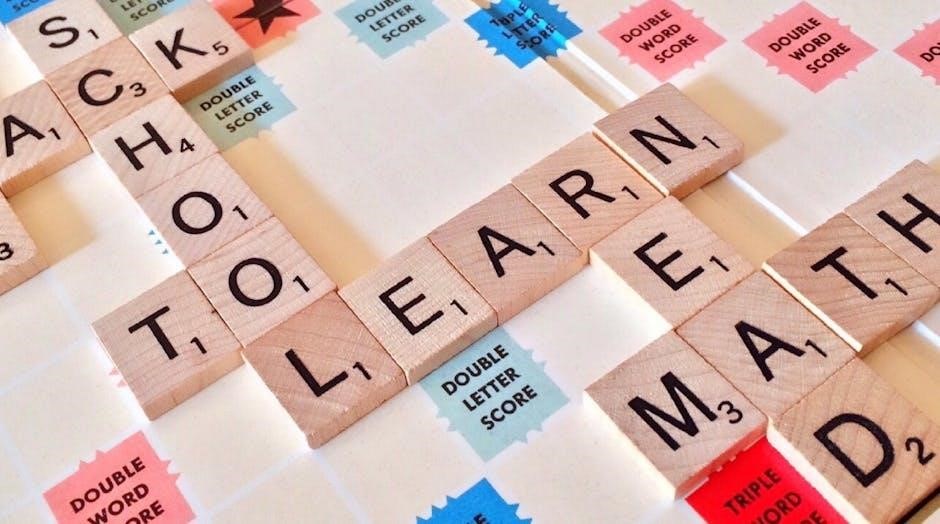The English Schools Athletics Standards 2024 are published by the ESAA, providing clear entry criteria for national events. The PDF document outlines performance benchmarks for all age groups and event categories, ensuring fair competition and identifying emerging talent across track and field disciplines.

Role of the English Schools Athletic Association (ESAA)
The English Schools Athletic Association (ESAA) plays a pivotal role in promoting and governing athletics in schools across England. As the national governing body, the ESAA is responsible for setting and maintaining high standards in school athletics, ensuring a competitive and fair environment for young athletes. The organization works closely with schools, teachers, and coaches to identify and nurture talent from an early age. By establishing clear guidelines and standards, the ESAA helps students progress from grassroots levels to national competitions. Their efforts also include organizing major events like the prestigious English Schools’ Championships, which serve as a platform for athletes to showcase their abilities. The ESAA’s commitment to athletics development is instrumental in fostering a culture of excellence and participation in schools nationwide.

Importance of Athletics Standards in Schools
Athletics standards in schools are essential for fostering a culture of excellence, promoting physical fitness, and developing mental resilience among students. These standards provide clear benchmarks, encouraging pupils to strive for improvement and gain a sense of achievement. By setting measurable goals, they help identify and nurture young talent, preparing students for higher levels of competition. Athletics standards also promote teamwork, discipline, and healthy competition, which are vital life skills. Schools use these benchmarks to track progress and motivate students to push their limits. Additionally, they ensure fairness and consistency in evaluating athletic performance, creating an equitable environment for all participants. Overall, athletics standards contribute to the holistic development of students, shaping not only their athletic abilities but also their character and confidence.
2024 Standards Overview
The 2024 English Schools Athletics Standards provide a comprehensive guide for athletes, coaches, and schools to measure performance and progression. These standards are designed to encourage participation, identify talent, and set achievable goals for athletes across various age categories and events. The standards are categorized into Senior Men, Senior Women, U23, Junior Boys, and Junior Girls, ensuring inclusivity and age-appropriate benchmarks. Each category outlines specific performance targets for track and field events, from sprint races to long-distance and field disciplines. The 2024 standards aim to promote healthy competition, track development, and prepare athletes for national and international competitions. They also serve as a motivational tool, helping schools nurture athletic talent effectively while fostering a culture of excellence and sportsmanship.
The Senior Men’s Standards for 2024 outline performance benchmarks across various track and field events, providing clear targets to help athletes qualify and excel at higher levels.
100 Metres Standards
The 2024 English Schools Athletics Standards for the 100 metres event in the Senior Men’s category are designed to reflect the competitive level required for national qualification. Athletes are expected to achieve a performance time of 11.1 seconds to meet the entry standard, while the qualifying time for the national finals is set at 11.0 seconds. These standards are established to identify talented athletes who demonstrate the potential to compete at the highest levels. The 100 metres remains a cornerstone event, and meeting these standards is a key indicator of an athlete’s readiness for advanced competition. The ESAA ensures these benchmarks align with national expectations, fostering consistency and excellence across school athletics programmes.
200 Metres Standards
The 2024 English Schools Athletics Standards for the 200 metres event in the Senior Men’s category are set to challenge athletes and identify those with national-level potential. The entry standard is 22.8 seconds, while the qualifying time for the national finals is 22.5 seconds. These standards reflect the progression from the 100 metres, requiring athletes to maintain speed over a longer distance. The ESAA establishes these benchmarks to ensure consistency and fairness across all regions. Achieving these times demonstrates an athlete’s ability to sustain performance and adapt to the demands of the 200 metres event. Meeting these standards is a significant step toward competing at the highest levels in school athletics.
Other Track and Field Events
Beyond sprint events, the 2024 English Schools Athletics Standards include comprehensive benchmarks for other track and field disciplines. For example, the 400 metres has entry standards of 51.0 seconds for Senior Men, while the 800 metres requires 1:58.0 minutes. Hurdles events, such as the 110m and 400m hurdles, have standards of 14.8 seconds and 56.5 seconds, respectively. Relay events and field events like long jump, high jump, and javelin also have specific qualifying marks. These standards ensure athletes meet competitive benchmarks, fostering growth and excellence. They provide clear targets for athletes to strive toward, preparing them for higher levels of competition while maintaining the integrity of school-level athletics.

Senior Women’s Standards
The 2024 standards for Senior Women outline competitive benchmarks across track and field events, including sprints, distances, hurdles, and field events, ensuring fairness and guiding athlete progression.
The 100 metres standards for Senior Women in the 2024 English Schools Athletics Standards aim to identify top-tier athletes. The target times are set to reflect national competitiveness, ensuring athletes meet rigorous benchmarks. These standards serve as qualification guidelines for major events, motivating athletes to push their limits. By achieving these times, competitors demonstrate exceptional speed and technique, showcasing their readiness for higher-level competitions. The standards also highlight the importance of training and dedication, encouraging athletes to strive for excellence. Schools and coaches use these benchmarks to track progress and prepare athletes effectively for upcoming races. Achieving these standards is a significant milestone, reflecting both individual and team potential.
The 200 metres standards for Senior Women in the 2024 English Schools Athletics Standards are designed to challenge athletes to achieve times that reflect national-level competitiveness. The standards are slightly higher than the 100 metres, requiring athletes to demonstrate both speed and endurance. Automatic timing standards are set at a faster pace than manual timing, ensuring accuracy and fairness. These benchmarks help identify athletes capable of excelling in regional and national competitions. Achieving these standards highlights an athlete’s ability to maintain speed over a longer distance, showcasing their stamina and technique. Schools and coaches use these standards to set realistic goals and monitor progress throughout the season. Meeting these times is a significant accomplishment, reflecting an athlete’s dedication and potential for success at higher levels.
Hurdles and Field Events
The 2024 English Schools Athletics Standards include specific benchmarks for Senior Women in hurdles and field events, ensuring a balanced approach to track and field disciplines. Sprint hurdles require athletes to demonstrate speed, agility, and technique over 80m or 100m races, with standards set to identify emerging talent. Field events such as long jump, high jump, and shot put have clear distance or height thresholds, reflecting national-level expectations. These standards encourage athletes to specialize while maintaining overall athletic versatility. Achieving these benchmarks is a testament to an athlete’s dedication and skill, providing a clear pathway for progression. Schools and coaches use these standards to identify potential and guide training programs effectively; Meeting these targets highlights an athlete’s readiness for higher-level competitions and future success in the sport.

U23 Men’s Standards
The 2024 standards for U23 men outline performance benchmarks across track and field events, setting clear targets for athletes transitioning to senior-level competitions.
100 Metres and 200 Metres
The 2024 standards for U23 men in the 100 metres and 200 metres events are designed to reflect the high performance levels expected at this developmental stage. For the 100 metres, athletes are expected to achieve times around 10.5 seconds, demonstrating explosive speed and technique. In the 200 metres, the target is approximately 21.2 seconds, emphasizing both speed and endurance. These standards are slightly tighter than previous years, reflecting the growing competitiveness in U23 athletics. They serve as a benchmark for identifying talented athletes who have the potential to progress to senior international competitions. Meeting these standards not only highlights an athlete’s current ability but also signals their readiness for further development at the national and international levels.
Long-Distance and Field Events
The 2024 standards for long-distance and field events reflect the progression of athletes in endurance and technical skills. For U23 men, the 5,000 metres and 10,000 metres events require times of approximately 14:30 minutes and 30:00 minutes, respectively, showcasing stamina and pacing abilities. In field events, athletes in the high jump are expected to clear around 2.05 metres, while pole vaulters aim for 4.60 metres. The long jump and triple jump standards are set at 7.35 metres and 14.50 metres, respectively. Throwers in the discus, javelin, and hammer events need to achieve distances of 50 metres, 65 metres, and 55 metres, respectively. These standards highlight the balance between power, technique, and endurance required for success in these disciplines.
U23 Women’s Standards
The U23 women’s standards emphasize competitive benchmarks across track and field events, balancing speed, endurance, and technique. Achieving these standards is crucial for national-level progression and athlete recognition.
The 2024 standards for U23 women in the 100 metres and 200 metres reflect the high performance expectations for emerging athletes. The 100 metres requires a time of 12.1 seconds, while the 200 metres demands 24.5 seconds, showcasing speed and endurance. These benchmarks are designed to identify athletes with the potential to compete at national and international levels. Achieving these standards highlights an athlete’s ability to excel in sprint events, emphasizing technique, acceleration, and stamina. Meeting these times not only qualifies athletes for major competitions but also underscores their progression in the sport. These events remain fundamental in assessing sprint capabilities and serve as a gateway to higher-tier athletics.
The 2024 standards for U23 women in long-distance and field events highlight the progression and skill required for advanced competition. In the 3000 metres, athletes must achieve 9:30 minutes, while the 5000 metres demands 16:50 minutes, reflecting endurance and stamina. For field events, the high jump standard is set at 1.75 metres, and the pole vault requires a clearance of 3.80 metres. These benchmarks assess both technical ability and physical prowess, ensuring athletes are prepared for high-level competitions. Meeting these standards signifies a strong foundation in both endurance and technique, essential for success in track and field. These events play a critical role in identifying future talent and fostering growth in athletics.

Junior Boys’ Standards
The 2024 standards for junior boys emphasize progression and development in athletics. These benchmarks are designed to challenge young athletes while fostering growth and talent identification, preparing them for higher-level competitions and future success in the sport.
The 2024 English Schools Athletics Standards for junior boys in the 100 metres and 200 metres events reflect a focus on identifying and nurturing young talent. The 100 metres standard is set at 11.5 seconds, while the 200 metres standard is 23.5 seconds, both designed to challenge athletes and encourage progression. These benchmarks are slightly adjusted from previous years to align with performance trends, ensuring they remain achievable yet aspirational. They aim to motivate junior athletes to improve their speed and technique, providing a clear pathway for development. These standards also serve as a foundation for potential future success in regional and national competitions, highlighting the importance of early-stage performance tracking.
Progression and Development
The 2024 English Schools Athletics Standards emphasize the importance of progression and development for junior athletes, fostering a pathway for long-term success. These standards are designed to encourage athletes to improve year-on-year, with tailored support from schools and coaches. By setting achievable yet challenging benchmarks, the standards motivate athletes to enhance their skills and physical abilities. This focus on development ensures that young athletes can gradually build their performance capabilities, preparing them for higher levels of competition. The standards also highlight the role of training programs and resources in nurturing talent, creating a strong foundation for future success in athletics.

Junior Girls’ Standards
The 2024 standards for junior girls outline performance benchmarks across track and field events, providing clear guidance for athletes and coaches to monitor progress and improvement effectively.
The 100 metres and 200 metres events are cornerstone sprint races for junior girls, with the 2024 standards reflecting the progression of young athletes in speed and technique. These distances require explosive power, acceleration, and endurance, making them ideal for assessing raw talent and developed skill. The standards are set to challenge athletes while remaining achievable for those with dedicated training. For junior girls, achieving these benchmarks not only highlights individual growth but also opens pathways to regional and national competitions. Schools and coaches play a vital role in nurturing these athletes, ensuring they meet the required times through structured training and performance tracking. Meeting these standards is a testament to both physical ability and mental resilience, setting a strong foundation for future athletic careers.
Progression and development are key focuses for junior girls in athletics, ensuring a balanced approach to growth and performance. The 2024 standards encourage athletes to build foundational skills and gradually improve, fostering long-term development. Coaches and schools play a crucial role in tailoring training programs to meet individual needs, emphasizing technique refinement and strength building. These standards help identify talent early, allowing for targeted support and guidance. By setting incremental goals, athletes can track their improvement, fostering confidence and resilience. This structured pathway not only prepares them for higher levels of competition but also instills a lifelong love for the sport. The emphasis is on holistic development, ensuring athletes grow both physically and mentally.
Year-over-Year Changes in Standards
The English Schools Athletics Standards 2024 emphasize the importance of progression and development for junior girls, providing a structured pathway for growth. These standards aim to help athletes gradually improve their skills and performance levels through targeted training and competition experience. Schools and coaches play a vital role in identifying talent early and nurturing it over time. The standards encourage a focus on technique, strength, and conditioning, ensuring athletes build a solid foundation for future success. By setting achievable goals and tracking progress, young athletes can gain confidence and develop resilience. This approach not only prepares them for higher levels of competition but also fosters a lifelong passion for athletics.

How to Qualify Using the Standards
To qualify for competitions using the English Schools Athletics Standards 2024, athletes must meet or exceed the specified times, distances, or heights for their event and age category. The process begins with achieving the required standard in a school or club competition, which must be verified by a qualified official. Athletes then register their performance with the English Schools Athletic Association (ESAA) through their school or athletics club. Once verified, they become eligible to compete in regional and national events. Coaches and teachers play a crucial role in identifying potential qualifiers and guiding them through the process. Meeting the standards not only secures qualification but also demonstrates an athlete’s readiness to compete at higher levels.

Benefits for Schools and Athletes
The English Schools Athletics Standards 2024 provide numerous benefits for both schools and athletes. For schools, these standards promote athletic excellence, fostering a competitive yet inclusive environment that encourages student participation. They also enhance school reputation by showcasing talent and dedication. Athletes benefit from clear performance targets, which guide training and motivate improvement. Meeting these standards can lead to opportunities such as competing in national events, gaining recognition, and potentially attracting scholarships or team selections. The standards also help athletes develop discipline, resilience, and teamwork skills, which are valuable beyond sports. Overall, the standards create a structured pathway for growth, benefiting both individuals and educational institutions by nurturing athletic and personal development.

Future Implications of the Standards
The English Schools Athletics Standards 2024 set a foundation for long-term development in school-level athletics. By establishing clear benchmarks, these standards will elevate performance levels and foster a culture of excellence. They encourage schools to invest in better training facilities and coaching, creating a competitive environment that nurtures talent. Over time, these standards will help identify and develop future national and international athletes, ensuring a strong pipeline of skilled competitors. Additionally, they promote consistency and fairness in evaluating athletic potential, which can lead to more opportunities for young athletes to progress in their careers. The standards also serve as a legacy, inspiring future generations to aim higher and achieve greatness in athletics.
How to Access the 2024 PDF
To access the English Schools Athletics Standards 2024 PDF, visit the official ESAA website. Navigate to the “Resources” or “Publications” section, where the document is typically hosted. Click on the provided link to download the PDF directly. Ensure you have a compatible device and internet connection for smooth access. The document is freely available to schools, athletes, and coaches, offering detailed standards for all events and age categories. Print or save the PDF for easy reference throughout the season. This resource is essential for tracking progress and understanding qualification criteria for competitions.
